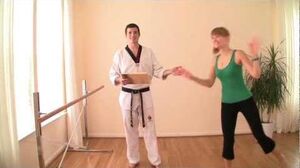
TaeKwonDo Board Breaking - A Beginners Guide
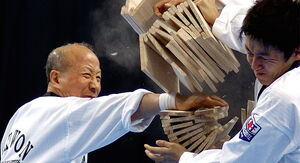
Kyu Hyung Lee demonstrates Power Breaking with a Spearhand Strike through a stack of boards held firmly. In this case, the boards are pegged as shown by the wooden spacers between each board.
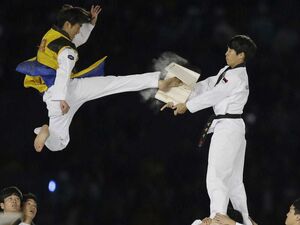
A member of the Kukkiwon Demo Team demonstrates Speed Breaking at the 2014 Incheon Asian Games. Note how the board is being held lightly, on just one side of the board. If the kick did not have good "snap" and precision, the board would wobble in the holder's hands rather than break.

A "Far Side" comic illustrating the martial arts emphasis on breaking
Taekwondo competitions typically include forms, sparring, and breaking events. In breaking competitions, the idea is to demonstrate power, speed, and technique. Typically wooden boards are broken, though ceramic and concrete tiles are also used. Advanced competitors may even break several boards in a single jump with multiple kicks before landing.
Types of Breaking[]
Generally speaking, there are two types of breaking:
- Speed Breaking - Some people use this term to refer to competitions that involve breaking many boards quickly, but in general the term Speed Breaking refers to breaking a single board (often a thin board) that is held lightly, or held on just one edge. The idea is that if your strike or kick isn't snapping very quickly into the center of the lightly-held board, the board will move rather than break. Speed Breaking demonstrates that your technique has good snap and precision.
- Power Breaking - This term generally refers to a single strike or kick that breaks through a stack of multiple boards or tiles that are held in place very rigidly. As the name indicates, Power Breaking demonstrates your breaking power, though of course accuracy is also essential (e.g., hitting a thick stack of tiles off-center makes them dramatically more difficult to break).
Some authors identify two additional types of breaking:
- Impulse Breaking is like Speed Breaking, except that the performer does not follow-through after contacting the board. Essentially, this is like a "hard tap" on the board, and then the hand or foot is immediately withdrawn from the board. Impulse Breaking is usually done against non-flexible materials, such as tiles.
- Soft Breaking (or "Ki Breaking") is a break that is performed with the palmheel as the striking surface.
VERY IMPORTANT NOTE: Children should generally not practice Power Breaking. Children's skeletons are incomplete, with tough cartilage standing in for bone until mid-puberty. As just one example, a child's thumb is not connected to the child's hand with bone, it is connected with cartilage. Over time the cartilage calcifies to become bone. If the cartilage is deformed (as by Power Breaking) then as the child ages and as the cartilage calcifies, the result will be a deformed bone.
Equipment[]
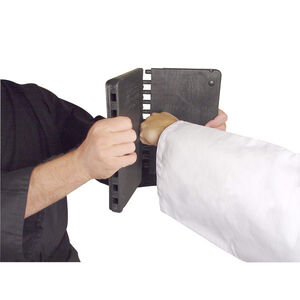
For home use especially, rebreakable boards offer an affordable approach for practice.
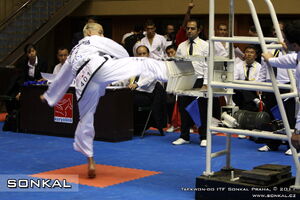
There are a variety of devices on the market for board-holding.
Wooden boards are the most common breaking item in taekwondo. Individual boards may range from sizes as small as 6"x12"x1" to as large as 12"x12"x1" (a board with a nominal width of 1" has an actual width of 3/4"). The typical adult testing board is approximately 10"x12"x1". The grain of the board must be cut so as to be parallel with the striking hand. Children may use narrower and thinner boards with 4 and 5 year olds sometimes breaking boards as small as 4"x12"x1/2". For home practice especially, many people purchase plastic rebreakable boards rather than using wooden boards.
In addition, there are a variety of board-holding devices on the market that facility solo-practice and also provide greater rigidity than having humans hold boards...this is especially important in Power Breaking.
Pegged vs. Unpegged[]
When boards are stacked with spacers in between each board, these are called pegged boards. In a pegged stack, the performer must maintain peak force much longer than in an unpegged stack, in order to keep breaking through boards.
Wood, which is a natural fibrous matrix, flexes to a certain degree before it snaps at the target point. When unpegged, this allows for an entire stack of wood to flex upon impact. Counter-intuitively, this means the resulting breaks occurr in the order of furthest board from impact to the closest board (albeit a fraction of a second difference separates each board, making it appear instantaneous). This can be witnessed in failed demonstrations where the rear board will break, but the remaining top boards are intact.
Board Poppers[]
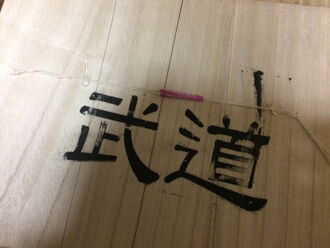
A board with a "cracker snap" affixed to the board. Hot glue can be seen on either end of the cracker-snap holding it to the board. The cracker-snap is taught on the board, so that a board-break will cause the cracker-snap to pop.
Especially during a Demo Team performance, it's not uncommon to apply "special effects" to boards. For example, one might affix "cracker snaps" to the board so that the boards make a more demonstrable "crack" when broken. Another technique is to dust the board with flour, so that when it breaks it releases a puff of visible dust into the air. The idea is that this helps audience members who are far away from the performance (for example, in high bleachers in an auditorium) hear and see the board break.
Applying Cracker Snaps[]
There are different techniques for applying cracker-snaps to boards. Some schools tape the cracker-snaps to the boards. Another technique is to hold the cracker-snap taught on the board with push-pins, apply hot-glue to either end of the cracker-snap, then remove the push-pins.
In Tournaments[]
Just as with poomsae competitions, breaking competitions should be a good show. So in addition to looking for technical correctness in the breaks (e.g., "was that kick performed with technical correctness") one is usually also looking for good "showmanship":
- Was there good stance, energy, and kihap leading up to the break.
- In addition to technical correctness, was there good speed, power, energy, and kihap during the break.
- After the break, was there a good return to stance, with good energy and kihap again.
In other words, as a judge you are looking for a "good show" in addition to technical correctness.
Of course the rules and scoring for breaking will vary greatly from one tournament to the next. In smaller regional competitions judging is often done on a 10-point scale, with 10 meaning a "perfect" performance (which should never or almost never be awarded, depending on the guidelines of your tournament) and athletes rarely receiving a score below 5. As with poomsae competitions, the start of judging might actually begin when the athlete enters the mat, and so can include evaluation of the athlete's courtesies, such as bowing respectfully when they enter the mat, well before the breaking even begins.
As an example of how evaluation factors can very from one tournament to the next, consider the case of failed-breaks:
- In some tournaments, the judging guidelines are that the athlete has 3 chance to break the board, and there are no deductions of points for failed breaks
- In other tournaments, the guidelines are that the athlete has as many chances as he likes, but each fail costs the athlete a point.
Scoring and Fairness in Judging[]
Typically there will be three judges, and the athlete's score is the sum of all three judges's scores. In the case of a tie, often the highest and lowest scores are tossed-out so that the middle-score rules. If there's still a tie after that, an approach is to pick the athlete with the highest single score.
A typical approach for judging breaking is to start with 10 points and deduct points or half-points for every flaw. Another approach, however -- equally valid -- is to assign a somewhat arbitrary score (like "7" or "8") to the first competitor in the division, and then judge all the other competitors based on how good they are in comparison to this first competitor.
- As long as each individual judge judges consistently, it generally doesn't matter which technique he uses. Since the final score is the sum of each judge's score, it generally doesn't matter if one judge is the "nice" judge (always awarding scores between 7 and 10) while another judge is a "mean" judge (always awarding scores between 5 and 8).
- Where the judge's approach can make a difference however is if one judge always clusters his scores (e.g., "always between 7 and 9") while another judge spreads his score ("always between 1 and 9"). This is why for smaller regional tournaments judges tend to stay in the 5.0-9.5 scoring range, because it keeps their score from outweighing the other judges's scores.
To announce scores, different tournaments use different systems.
- Some tournaments provide judges scoring cards
- Other tournaments have the judges hold up fingers for the number of points awarded
- In some tournaments, the judge's arms are crossed to denote a .5 add to the number of fingers shown
- In other tournaments, the judges hold up their hands twice: once to show the unit score, then again after a few seconds to show the decimal score (with a closed-fist denoting a zero decimal)
As with all scoring, judges should not look at their fellow judges while awarding points; you don't want to create the perception that you based on your score on your fellow judges' scores.
Criticisms and Defense of Breaking[]
Some people criticize breaking under the principle that "boards don't fight back." There are several reasons why breaking is considered important in taekwondo:
- In some styles of taekwondo, sparring is done with light-contact and minimal padding, which means breaking is the only method available to demonstrate a practitioner's power.
- More importantly though is that breaking requires tremendous precision. To break consistently, one must strike with good snap at the center of the target every time. This is especially tricky when it comes to high kicks: it's difficult to control one's leg with such precision that one can strike the same high point every time; practicing this increases a person's precision. In principle then, in a self-defense situation, this precision in your techniques will give you an advantage.
Frequent practice at breaking will also result in body-hardening, in which the hard and soft tissues of the body (bone, skin, cartilage, etc.) become progressively tougher with practice.
References[]
- Breaking Techniques on Black Belt Wiki
- Tips for Breaking on Taekwondo Animals
- Taekwondo Breaking on Taekwondo Preschool